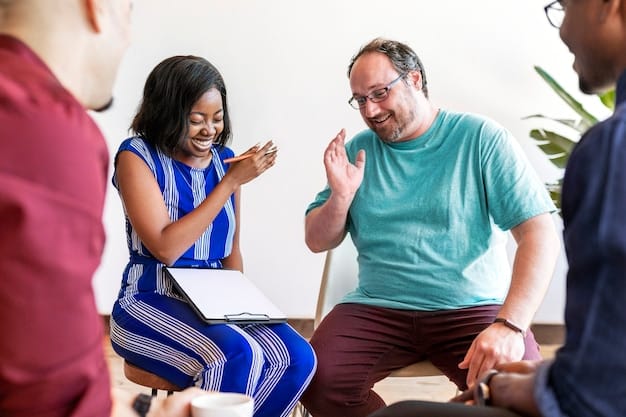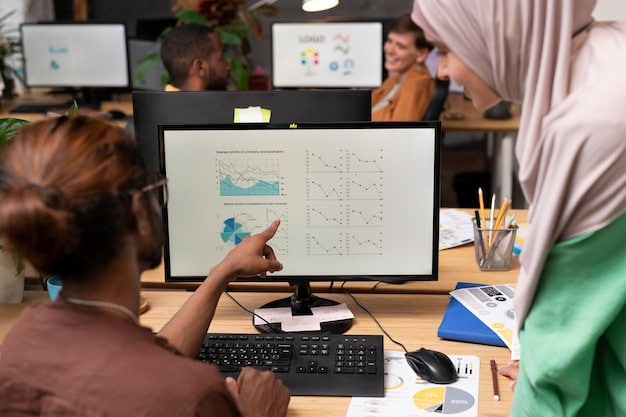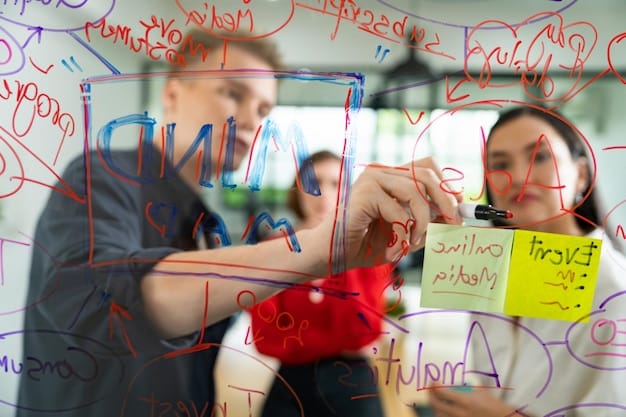Train Your Team in Inclusive Communication: A Step-by-Step Guide

Training your team in inclusive communication is essential for fostering a respectful workplace, improving collaboration, enhancing innovation, and ensuring all voices are heard and valued within an organization, leading to greater success and employee retention.
In today’s diverse workplaces, effective communication is no longer just about clarity; it’s about inclusion. Learning How to Train Your Team in Inclusive Communication: A Step-by-Step Guide is paramount for cultivating an environment where every voice is heard, valued, and respected. This guide provides a detailed blueprint to empower your team with the skills necessary to build a truly inclusive, productive, and harmonious work culture.
Understanding the Foundation of Inclusive Communication
Inclusive communication extends beyond simple politeness; it’s a deliberate practice designed to ensure everyone feels respected, valued, and understood, regardless of their background, identity, or communication style. Establishing this foundation is the first critical step in any successful training program.
This involves recognizing that communication barriers often stem from unconscious biases or a lack of awareness regarding diverse perspectives. By proactively addressing these foundational elements, organizations can foster a culture where empathy and understanding are prioritized.
Defining Inclusivity and Its Impact
Inclusivity in communication means actively creating an environment where all individuals, regardless of their background, abilities, or identity, feel safe, respected, and empowered to express themselves. Its impact on team dynamics and overall organizational success is profound.
- 🚀 Boosts psychological safety, encouraging open dialogue.
- 💡 Fosters diverse perspectives, leading to richer innovation.
- 🤝 Enhances team cohesion and builds stronger relationships.
- ⬆️ Improves employee engagement and retention rates.
Without inclusive communication, workplaces risk alienating talent, stifling creativity, and creating environments where some voices are inadvertently silenced, leading to a less vibrant and less effective workforce. Recognizing this broad impact is vital for leadership.
Recognizing Barriers to Inclusive Communication
Identifying common barriers is crucial for effective intervention. These can range from subtle microaggressions to ingrained systemic biases within organizational structures. Often, these barriers are not intentional but result from unawareness or a lack of tools.
- 🗣️ Use of jargon or acronyms not universally understood.
- 👂 Passive listening or interrupting speakers.
- Stereotypes influencing how messages are interpreted.
- 🚫 Lack of accessible communication channels for diverse needs.
Addressing these barriers requires a conscious effort and a commitment to continuous learning and adaptation, as new challenges emerge with evolving workplace demographics and societal norms.
Understanding these foundational concepts prepares the ground for more targeted training. It shifts the mindset from mere politeness to a strategic approach to communication that genuinely impacts an organization’s bottom line and cultural health. This initial phase sets the tone for all subsequent training modules.
Assessing Your Team’s Current Communication Landscape
Before implementing any training, it’s essential to understand where your team currently standsregarding communication. This diagnostic phase helps tailor the training to specific needs, ensuring relevance and maximizing impact.
A comprehensive assessment will reveal not only areas for improvement but also existing strengths that can be leveraged. This data-driven approach ensures that the training is not a one-size-fits-all solution, but a targeted intervention.
Conducting Communication Audits and Surveys
Formal audits and anonymous surveys are excellent tools for gathering unfiltered feedback on current communication practices. These methods allow employees to express concerns and observations without fear of reprisal, providing invaluable insights.
- 📊 Anonymous feedback surveys on communication effectiveness.
- 👥 Focus groups to delve deeper into specific issues.
- Observational assessments of team meetings and interactions.
- 🗣️ One-on-one interviews with team members across departments.
The goal is to identify patterns, common pain points, and areas where communication breakdowns occur most frequently. This qualitative and quantitative data forms the bedrock of a truly effective training strategy.
Identifying Specific Areas for Improvement
Once data is collected, the next step is to analyze it to pinpoint precise areas requiring attention. This might include anything from addressing unconscious bias in language to improving active listening skills among leadership or fostering a more open feedback culture.
For example, a survey might reveal that certain teams feel their ideas are not heard, suggesting a need for active listening training. Another finding might be that inter-departmental communication is strained, highlighting the importance of clear, accessible language across silos.

This assessment phase is dynamic; it informs the training content and provides baseline metrics against which the success of the training can later be measured. It ensures that the resources allocated to training are directed towards the most impactful areas, leading to measurable improvements in team communication.
Developing a Comprehensive Training Curriculum
With a clear understanding of your team’s current state, the next crucial step is designing a training curriculum that addresses identified needs. This curriculum should be well-structured, engaging, and practical, covering both foundational principles and actionable strategies.
A successful curriculum balances theoretical knowledge with hands-on application, enabling participants to immediately implement what they learn in their daily interactions. It also considers various learning styles to ensure maximum engagement.
Core Modules for Inclusive Communication Training
A robust curriculum should incorporate several key modules, systematically building participants’ understanding and skills. Each module should have clear learning objectives and practical exercises.
- 👁️ Unconscious Bias Awareness: Exploring implicit biases and their impact on communication.
- 🗣️ Active Listening and Empathy: Developing skills to truly hear and understand others’ perspectives.
- ✍️ Inclusive Language and Terminology: Learning to use respectful and non-discriminatory language.
- 💬 Feedback and Conflict Resolution: Practicing constructive feedback and effective conflict management.
These modules are not isolated; they are interconnected, building a holistic understanding of inclusive communication. For instance, understanding unconscious bias is fundamental to employing inclusive language and practicing empathetic listening effectively.
Incorporating Diverse Learning Methodologies
To cater to different learning styles and keep participants engaged, the curriculum should use a variety of methodologies. This might include interactive workshops, role-playing scenarios, case studies, and multimedia resources.
For example, role-playing exercises allow participants to practice difficult conversations in a safe environment, while case studies provide real-world examples to analyze and discuss. Online modules can offer flexibility for self-paced learning, complementing in-person sessions.
The development of this curriculum should also consider the specific challenges and nuances of your organization. Tailoring exercises and examples to your workplace context further enhances relevance and makes the learning more impactful for your team members.
By thoughtfully designing a comprehensive and varied curriculum, you equip your team with the practical tools and foundational understanding needed to cultivate a truly inclusive communication culture that benefits everyone.
Executing the Training Program
Once the curriculum is developed, the focus shifts to the seamless execution of the training program. This phase involves logistical planning, selecting facilitators, and ensuring a supportive learning environment.
Effective execution ensures that the carefully crafted curriculum translates into meaningful learning experiences for all participants, paving the way for real behavioral changes within the team.
Choosing the Right Facilitators and Trainers
The success of the training largely depends on the facilitators. They should possess not only deep expertise in inclusive communication but also strong interpersonal skills to guide discussions, manage group dynamics, and foster a comfortable learning atmosphere.
Consider whether internal resources can be developed or if external experts are needed. External facilitators might bring fresh perspectives and specialized knowledge, while internal trainers may have a deeper understanding of the organization’s unique culture and challenges.
Crucially, facilitators should embody the principles of inclusive communication themselves, serving as role models throughout the training. Their ability to facilitate open, brave conversations can significantly enhance the learning outcome.
Structuring Training Sessions for Maximum Impact
Training sessions should be structured to optimize engagement and retention. This means balancing didactic content with interactive elements, ensuring that participants remain active learners rather than passive recipients of information.
- ⏱️ Keep sessions concise to maintain attention spans.
- 🔄 Incorporate frequent breaks and interactive activities.
- Facilitate small group discussions for deeper engagement.
- Provide practical, real-world scenarios for role-playing.
Starting with an overview of learning objectives, moving into core content, and then applying concepts through exercises, helps solidify understanding. Concluding with a summary and opportunities for participants to ask questions ensures clarity and addresses any lingering doubts.
Flexibility in scheduling and delivery formats (e.g., in-person, virtual, blended) can also increase participation and accommodate diverse team needs. The goal is to make the training accessible and effective for every individual throughout the organization.
By meticulously planning and executing the training program, organizations lay the groundwork for genuinely transformative changes in how their teams communicate, leading to a more inclusive and productive environment.
Reinforcing Inclusive Communication Practices
Training is not a one-time event; it’s the beginning of a continuous journey. To ensure that inclusive communication practices become ingrained in the organizational culture, ongoing reinforcement and support are essential.
This phase focuses on sustaining the momentum generated by the training, providing platforms for continued learning, and embedding inclusive practices into daily operations and recognition systems.
Creating Opportunities for Continuous Learning and Practice
Learning should extend beyond formal training sessions. Organizations should foster a culture where continuous learning and practice of inclusive communication are encouraged and supported.
- 📚 Establishing a resource library with relevant articles, books, and videos.
- Peer-to-peer mentoring programs focused on communication skills.
- Regular “check-in” sessions or workshops to refresh knowledge.
- Incorporating inclusive communication topics into team meetings.
Providing safe spaces for practice and feedback, such as mock difficult conversations or scenario analyses, allows team members to refine their skills without fear of making mistakes in real-time, high-stakes situations.

These ongoing opportunities reinforce the message that inclusive communication is a vital, evolving skill crucial for individual and organizational success. It transitions from a training topic to an embedded behavioral expectation.
Integrating Inclusive Practices into Company Culture
For inclusive communication to truly thrive, it must be woven into the fabric of the company culture. This means aligning HR policies, performance reviews, and leadership behaviors with inclusive principles.
For instance, incorporating inclusive communication as a competency in performance evaluations signals its importance. Recognizing and rewarding team members who consistently demonstrate exemplary inclusive practices can further encourage adoption.
Leadership plays a critical role in setting the tone. When leaders actively model inclusive communication, they create a powerful ripple effect throughout the organization. This top-down commitment is essential for fostering an environment where inclusive communication is not just a policy but an inherent value.
By consistently reinforcing these practices through various channels, organizations can build a workplace where inclusive communication is the norm, fostering an environment of respect, understanding, and collaboration that fuels innovation and success.
Measuring the Impact and Iterating the Process
The final, but equally critical, stage of training your team in inclusive communication involves measuring the impact of your efforts and using that data to iterate and improve the process. Without measurement, it’s impossible to confirm the effectiveness of your training and justify future investments.
This phase embodies a continuous improvement approach, ensuring that the training evolves with the organization’s needs and remains relevant and impactful over time.
Establishing Metrics for Success
Defining clear, measurable metrics from the outset is crucial for evaluating the training program’s success. These metrics should align with the initial assessment findings and organizational goals.
- 📉 Reduction in communication-related conflicts or complaints.
- 📈 Increase in employee engagement and retention scores.
- Improved scores on diversity and inclusion surveys.
- Higher rates of participation in team discussions and feedback sessions.
Qualitative feedback, such as testimonials from employees describing specific instances where inclusive communication made a positive difference, can complement quantitative data, providing a more holistic picture of the impact.
Regularly collecting and analyzing this data allows organizations to track progress, identify areas where further intervention might be needed, and celebrate successes, which can further motivate continued efforts.
Gathering Feedback and Making Adjustments
Beyond quantitative metrics, actively soliciting feedback from participants and stakeholders is vital for ongoing improvement. This feedback provides insights into what worked well, what didn’t, and what could be done differently in the future.
Post-training surveys, follow-up focus groups, and informal check-ins can gather valuable qualitative data. This feedback loop allows for agile adjustments to the curriculum, methodologies, or reinforcement strategies.
For example, if feedback consistently highlights a particular module as less effective, it can be revised or replaced. If certain teams struggle with specific aspects of inclusive communication, targeted follow-up sessions can be arranged.
This iterative process ensures that the inclusive communication training remains dynamic and responsive to the evolving needs of the team and the organization. It transforms the training from a static program into a living initiative that continuously fosters a more inclusive and effective communication culture within the workplace.
By embracing this continuous cycle of assessment, training, reinforcement, and measurement, organizations can build and sustain a truly inclusive communication environment that benefits every individual and drives collective success.
| Key Step | Brief Description |
|---|---|
| 🌱 Foundation | Understand and define inclusive communication and its organizational impact. |
| 🔍 Assessment | Conduct audits to identify current strengths and areas for improvement. |
| 📚 Curriculum | Develop varied modules covering bias, active listening, and inclusive language. |
| 🔄 Reinforcement | Integrate continuous learning and practice into daily operations and culture. |
Frequently Asked Questions
Inclusive communication ensures that every team member feels respected, heard, and valued regardless of their background or identity. It’s crucial because it fosters psychological safety, boosts collaboration, enhances innovation by welcoming diverse perspectives, and ultimately leads to higher employee satisfaction and retention rates within an organization.
Identifying communication barriers can be achieved through anonymous surveys, focus groups, and observational audits. These methods help uncover issues like unconscious biases, exclusive language, passive listening, and inconsistent communication channels. Analyzing this feedback provides a clear picture of specific areas needing improvement and tailored training.
Core modules typically include unconscious bias awareness, active listening and empathy development, inclusive language and terminology, and constructive feedback and conflict resolution skills. These interconnected modules provide a comprehensive understanding and practical tools necessary for fostering respectful and effective interactions among team members.
To ensure lasting impact, reinforcement is key. This involves creating continuous learning opportunities, such as resource libraries and peer mentoring, and integrating inclusive practices into the company culture. By embedding communication values into performance reviews and ensuring leadership models inclusive behavior, the training moves from a one-off event to an organizational standard.
Success can be measured by tracking metrics like reduced communication-related conflicts, improved employee engagement survey scores, and higher participation in team discussions. Gathering qualitative feedback through post-training surveys and discussions also provides valuable insights into perceived behavioral shifts and overall cultural improvements, allowing for continuous refinement of the program.
Conclusion
Training your team in inclusive communication is an ongoing strategic investment that yields substantial returns in terms of workplace culture, productivity, and employee well-being. By thoughtfully assessing existing communication landscapes, crafting a tailored curriculum, executing engaging training sessions, and implementing robust reinforcement mechanisms, organizations can cultivate an environment where every voice contributes to collective success. It’s a journey that prioritizes respect, understanding, and empathy, transforming how teams interact and ultimately defining the strength and resilience of the entire organization in an increasingly diverse world.





